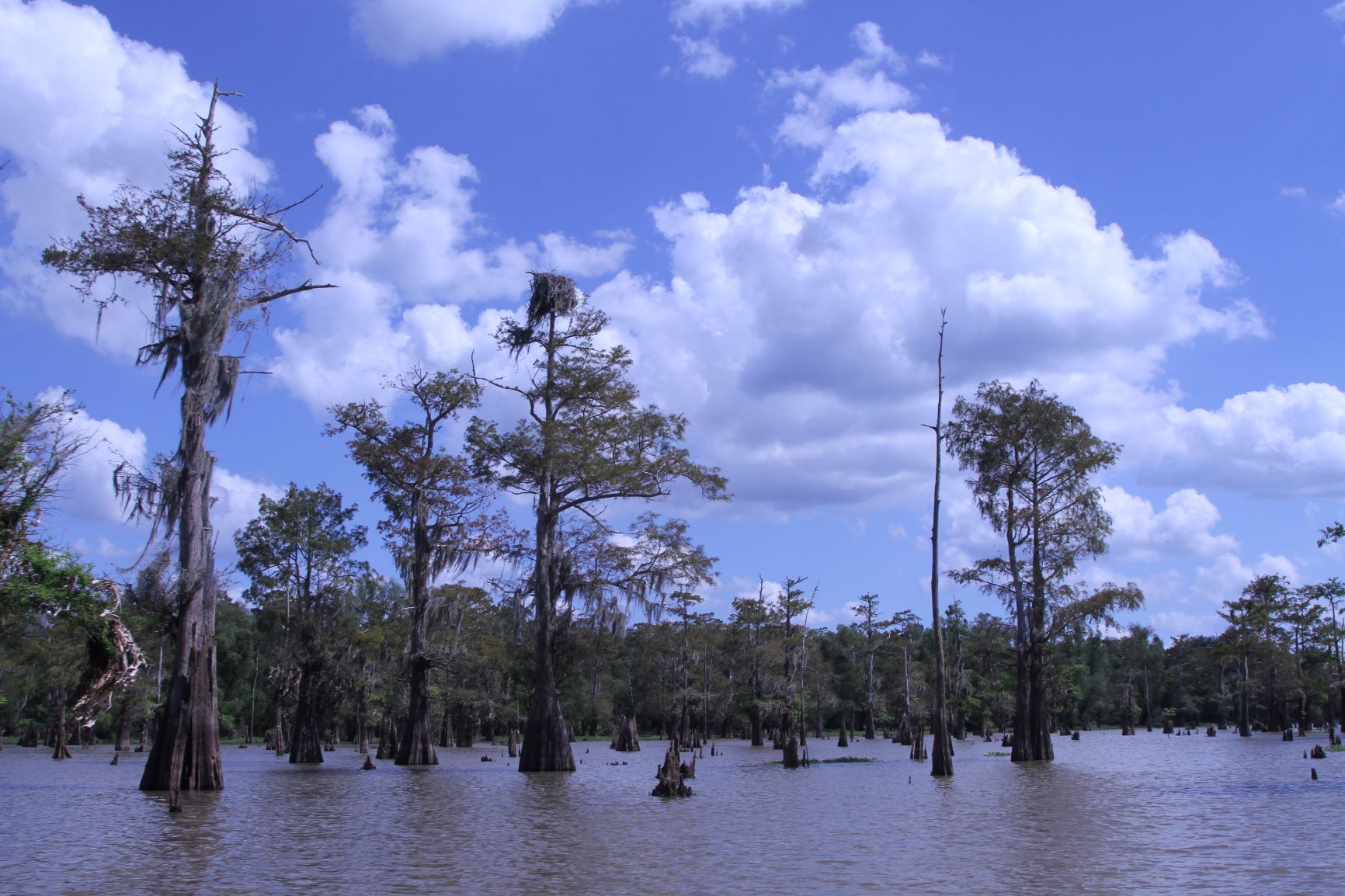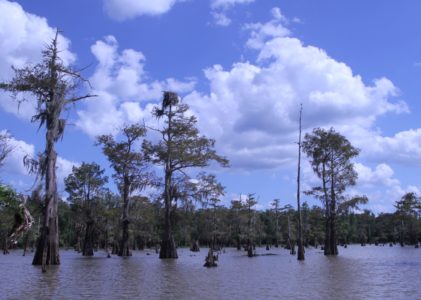Written by Naomi Yoder / Published October 8 2019 / Originally published here
A spoil bank is the pile of soil and debris left behind by the excavation and dredging machines that dig a trench through the swamp. In coastal Louisiana, all of the pipelines are buried or submerged (as opposed to being built above ground). The method for burying the pipe, then, is to dig an enormous trench. The material from the trench is then dumped right next to the new channel, and suddenly a wall is created that cuts off water and organisms from each other that were connected before. Companies are required by law, according to their permits, to return these spoil banks to their natural state once constructions is complete. However, very few companies comply with this stipulation in their permit leading to a basin filled with spoil banks, limited access to bayous and less productive crawfishing harvests.
—–
It was a crystal clear day in the western Atchafalaya Basin. Our group gathered at the boat launch at Bayou Benoit just upstream of Lake Fausse Pointe State Park. You would hardly know that just six weeks earlier, the water line was well above our heads, almost to the steep grassy rise of the levee next to the bayou. We gathered with Dean Wilson, Executive Director of the Atchafalaya Basinkeeper (https://www.basinkeeper.org/), our intrepid guide.

Our boat captains were all representatives from the Louisiana Crawfish Producers Association West (http://lcpawest.com/). They knew the basin like the back of their hand. With these capable people, all passionate about the swamps and the basin, we set out to visit one section of the Bayou Bridge Pipeline. The controversial pipeline has been operational since April 2019. The occasion for our visit was to view the spoil banks and the pipeline right-of-way, since the water is now low. Whether or not you agree with petrochemicals being delivered via this pipeline, the cold hard fact is that pipeline construction in coastal Louisiana has been unbelievably disastrous for the ecology and hydrology of the region. That’s why the Crawfish Producers agreed to spend their time toting us around. They want everyone to know: the basin is damaged beyond recognition. The consensus among the LCPA and Atchafalaya Basinkeeper seems to be that the only way the basin can be restored to anything close to “normal” is to level the spoil banks, and leave the mess alone.


Two views of spoil banks from the Bayou Bridge Pipeline. The left photo shows the elevation of the old swamp, above which the “wall” of excavation becomes lumpy and sloped. The right photo shows Dean Wilson atop the spoil bank looking west. The spoil bank is easily 10 feet high in its lower spots.
A spoil bank is the pile of soil and debris left behind by the excavation and dredging machines that dig a trench through the swamp. In coastal Louisiana, all of the pipelines are buried or submerged (as opposed to being built above ground). The method for burying the pipe, then, is to dig an enormous trench. The material from the trench is then dumped right next to the new channel, and suddenly a wall is created that cuts off water and organisms from each other that were connected before. Companies are required by law, according to their permits, to return these spoil banks to their natural state once constructions is complete. However, very few companies comply with this stipulation in their permit leading to a basin filled with spoil banks, limited access to bayous and less productive crawfishing harvests.
These spoil banks and fill are why the LCPA are escorting us wherever we want to go. When the water in the basin is fragmented and blocked off into a confined area, the water becomes stagnant. It can also become warm. Both of these conditions create a much less productive water body. Organisms need the oxygen in flowing water. If the water is stagnant, oxygen becomes depleted (this condition is known as hypoxia) and the fish die and the birds forage elsewhere and the whole system is disrupted. According to the LCPA fisherfolk, bayous which were highly productive areas before the Bayou Bridge Pipeline construction began now see fish kills on a regular basis. Furthermore, this is not the only pipeline with spoil banks creating walls in the basin. The Atchafalaya is literally criss-crossed with pipelines (see map). Bayou Bridge Pipeline is not the first to impact the ecosystem. It is more like the last straw for the healthy functioning of the region. The other pipelines were already wreaking havoc on ecological processes and fisheries in the basin. Now, the construction and obstruction of Bayou Bridge “wall” pipeline threatens to flatten the ecological function and ecosystem services the Atchafalaya Basin provides.

Map depicts pipelines that traverse the Atchafalaya Basin. Louisiana Department of Natural Resources issues permits for all pipelines and development projects built in wetlands (shown as turquoise lines). A selection of petrochemical pipelines are labeled.
The Atchafalaya Basin is rich with wildlife and swampy beauty. A partial list of bird species sighted on this one day includes Anhinga, Bald Eagle, Belted Kingfisher, Great Blue Heron, Great Egret, Osprey, Roseate Spoonbill, Tricolor Heron, and White Ibis. Fortunately, some of the views of wildlife and the swamp beauty are still available to me and my generation. Let’s just hope that we can find solutions to make sure the birds, fish, swamps and crawfish are available for future generations.

A roseate spoonbill (Platalea ajaja) in flight over Bayou Benoit, Atchafalaya Basin.


